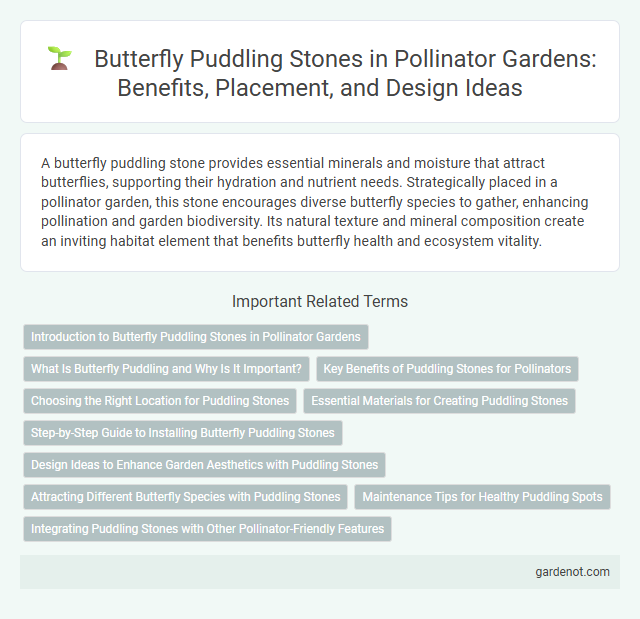A butterfly puddling stone provides essential minerals and moisture that attract butterflies, supporting their hydration and nutrient needs. Strategically placed in a pollinator garden, this stone encourages diverse butterfly species to gather, enhancing pollination and garden biodiversity. Its natural texture and mineral composition create an inviting habitat element that benefits butterfly health and ecosystem vitality.
Introduction to Butterfly Puddling Stones in Pollinator Gardens
Butterfly puddling stones provide essential minerals and moisture that attract butterflies to pollinator gardens, enhancing biodiversity and supporting pollinator health. These stones are typically placed in damp areas or shallow water, allowing butterflies to extract nutrients like sodium and amino acids vital for reproduction and vitality. Incorporating butterfly puddling stones into pollinator gardens promotes butterfly activity and contributes to a thriving ecosystem.
What Is Butterfly Puddling and Why Is It Important?
Butterfly puddling is a behavior where butterflies gather on moist surfaces like puddling stones to extract essential minerals and nutrients such as sodium and amino acids. These nutrients are crucial for reproductive success and overall health, enhancing the butterfly's ability to survive and reproduce. Providing butterfly puddling stones in pollinator gardens supports butterfly populations by supplying vital resources often missing from nectar alone.
Key Benefits of Puddling Stones for Pollinators
Butterfly puddling stones provide essential minerals and nutrients like sodium and amino acids that are crucial for butterfly hydration and reproductive success. These stones create a natural source of moisture mixed with salts, attracting pollinators and supporting their energy metabolism and mating behaviors. Incorporating puddling stones into a pollinator garden enhances biodiversity by sustaining butterfly populations and improving overall ecosystem health.
Choosing the Right Location for Puddling Stones
Selecting the ideal location for butterfly puddling stones involves placing them in sunny, sheltered spots where butterflies naturally congregate to drink and extract minerals. Position stones near flowering plants and moist soil to enhance accessibility and attract a diverse range of butterfly species. Ensuring the area remains damp and free from strong winds increases the effectiveness of puddling stones in supporting butterfly hydration and nutrient intake.
Essential Materials for Creating Puddling Stones
Essential materials for creating butterfly puddling stones include natural clay, which holds moisture and provides a textured surface for butterflies to land on. Incorporating fine sand and organic compost enriches the mineral content, attracting butterflies seeking nutrients such as sodium and amino acids. A shallow, porous stone or ceramic base ensures proper drainage and prevents water stagnation, promoting a healthy and effective puddling spot in pollinator gardens.
Step-by-Step Guide to Installing Butterfly Puddling Stones
To install butterfly puddling stones effectively, first select a sunny, sheltered spot near nectar-rich plants and dig a shallow basin about 2-3 inches deep. Place the stone inside the basin and fill the surrounding area with a mixture of sand and soil, ensuring the stone surface remains exposed and slightly moist to attract butterflies. Maintain consistent moisture by lightly watering the area regularly, creating an ideal habitat for butterflies to hydrate and absorb essential minerals.
Design Ideas to Enhance Garden Aesthetics with Puddling Stones
Butterfly puddling stones, crafted with textured surfaces and embedded minerals, serve as a focal point that attracts butterflies while adding visual interest to pollinator gardens. Incorporating natural shapes and vibrant colors harmonizes these stones with surrounding plants, creating a dynamic landscape that encourages butterfly activity. Positioning puddling stones near nectar-rich flowers enhances garden aesthetics and supports butterfly hydration and nutrient intake.
Attracting Different Butterfly Species with Puddling Stones
Butterfly puddling stones provide essential minerals that attract diverse butterfly species seeking nutrients for reproduction and survival. These stones, often moist and enriched with minerals like sodium, create prime puddling sites that encourage butterflies such as swallowtails, monarchs, and blues to congregate. Incorporating puddling stones into a pollinator garden enhances biodiversity by supporting the nutritional needs of multiple butterfly species.
Maintenance Tips for Healthy Puddling Spots
Regularly clean butterfly puddling stones by gently rinsing with water to remove dirt and debris, ensuring fresh minerals are accessible. Replenish the area with moist soil or sand mixed with natural salts to maintain an inviting environment for butterflies seeking nutrients. Position stones in sunny, sheltered spots to prevent mold growth and encourage consistent butterfly activity.
Integrating Puddling Stones with Other Pollinator-Friendly Features
Butterfly puddling stones can be seamlessly integrated with native wildflower beds and nectar-rich plants to create a holistic pollinator garden environment. Placing these stones near shallow water sources and sunlit areas encourages butterflies to hydrate and gather essential minerals, enhancing their pollination activity. Strategically combining puddling stones with sheltering shrubs and flowering herbs supports diverse pollinator species and promotes ecosystem health.
Butterfly puddling stone Infographic

 gardenot.com
gardenot.com